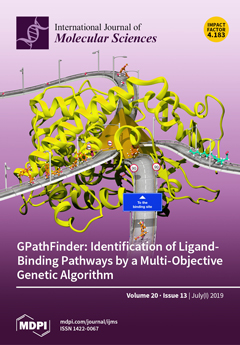We describe a 7-year-old male with high functioning autism spectrum disorder (ASD) and maternally-inherited rare missense variant of Synaptotagmin-like protein 4 (
SYTL4) gene (Xq22.1; c.835C>T; p.Arg279Cys) and an unknown missense variant of Transmembrane protein 187 (
TMEM187) gene (Xq28; c.708G>T; p.
[...] Read more.
We describe a 7-year-old male with high functioning autism spectrum disorder (ASD) and maternally-inherited rare missense variant of Synaptotagmin-like protein 4 (
SYTL4) gene (Xq22.1; c.835C>T; p.Arg279Cys) and an unknown missense variant of Transmembrane protein 187 (
TMEM187) gene (Xq28; c.708G>T; p. Gln236His). Multiple in-silico predictions described in our study indicate a potentially damaging status for both X-linked genes. Analysis of predicted atomic threading models of the mutant and the native SYTL4 proteins suggest a potential structural change induced by the R279C variant which eliminates the stabilizing Arg279-Asp60 salt bridge in the N-terminal half of the SYTL4, affecting the functionality of the protein’s critical RAB-Binding Domain. In the European (Non-Finnish) population, the allele frequency for this variant is 0.00042. The
SYTL4 gene is known to directly interact with several members of the RAB family of genes, such as,
RAB27A, RAB27B, RAB8A, and
RAB3A which are known autism spectrum disorder genes. The
SYTL4 gene also directly interacts with three known autism genes:
STX1A,
SNAP25 and
STXBP1. Through a literature-based analytical approach, we identified three of five (60%) autism-associated serum microRNAs (miRs) with high predictive power among the total of 298 mouse Sytl4 associated/predicted microRNA interactions. Five of 13 (38%) miRs were differentially expressed in serum from ASD individuals which were predicted to interact with the mouse equivalent
Sytl4 gene.
TMEM187 gene, like
SYTL4, is a protein-coding gene that belongs to a group of genes which host microRNA genes in their introns or exons. The novel Q236H amino acid variant in the TMEM187 in our patient is near the terminal end region of the protein which is represented by multiple sequence alignments and hidden Markov models, preventing comparative structural analysis of the variant harboring region. Like
SYTL4, the
TMEM187 gene is expressed in the brain and interacts with four known ASD genes, namely,
HCFC1; TMLHE; MECP2; and
GPHN. TMM187 is in linkage with
MECP2, which is a well-known determinant of brain structure and size and is a well-known autism gene. Other members of the
TMEM gene family,
TMEM132E and
TMEM132D genes are associated with bipolar and panic disorders, respectively, while
TMEM231 is a known syndromic autism gene. Together,
TMEM187 and
SYTL4 genes directly interact with recognized important ASD genes, and their mRNAs are found in extracellular vesicles in the nervous system and stimulate target cells to translate into active protein. Our evidence shows that both these genes should be considered as candidate genes for autism. Additional biological testing is warranted to further determine the pathogenicity of these gene variants in the causation of autism.
Full article






